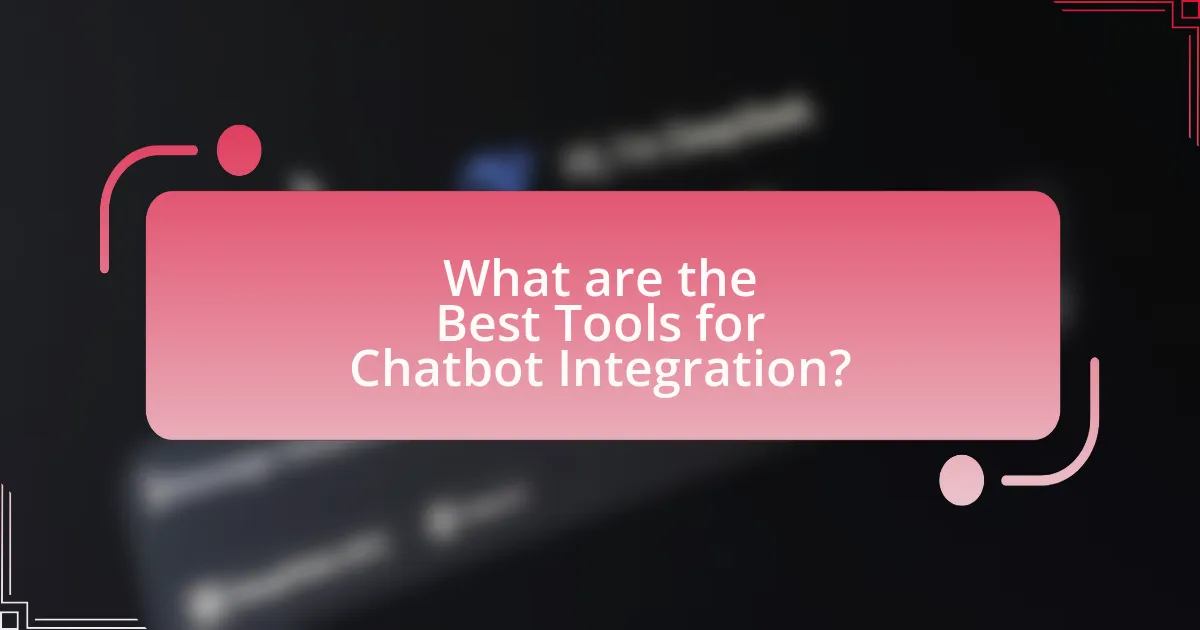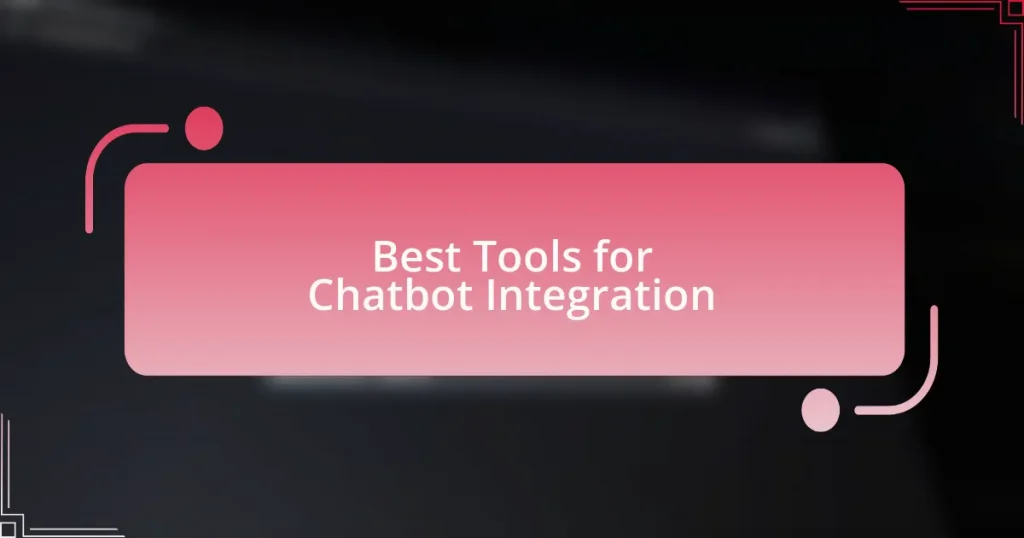The article focuses on the best tools for chatbot integration, highlighting key platforms such as Dialogflow, Microsoft Bot Framework, and Chatfuel. It discusses how these tools enhance chatbot functionality through features like natural language processing, machine learning, and multi-platform support, which significantly improve user experience. The article also outlines essential features to consider when selecting integration tools, compares the strengths and pricing of popular options, and examines the benefits across various industries. Additionally, it addresses common challenges in integration, best practices for successful implementation, and metrics for measuring chatbot performance.

What are the Best Tools for Chatbot Integration?
The best tools for chatbot integration include Dialogflow, Microsoft Bot Framework, and Chatfuel. Dialogflow, developed by Google, offers natural language understanding and can integrate with various platforms like Facebook Messenger and Slack. Microsoft Bot Framework provides a comprehensive environment for building and connecting bots across multiple channels, including Skype and Teams. Chatfuel is a user-friendly platform specifically designed for Facebook Messenger, allowing users to create bots without coding. These tools are widely recognized for their robust features and ease of use, making them popular choices for businesses looking to implement chatbots effectively.
How do these tools enhance chatbot functionality?
These tools enhance chatbot functionality by providing advanced features such as natural language processing, machine learning capabilities, and integration with various platforms. Natural language processing allows chatbots to understand and respond to user queries more accurately, improving user experience. Machine learning capabilities enable chatbots to learn from interactions, allowing them to provide more personalized responses over time. Additionally, integration with platforms like CRM systems and social media enhances the chatbot’s ability to access and utilize data, leading to more relevant and timely interactions. For instance, tools like Dialogflow and Microsoft Bot Framework have been shown to significantly improve response accuracy and user engagement metrics in various case studies.
What features should you look for in chatbot integration tools?
When selecting chatbot integration tools, prioritize features such as multi-platform support, natural language processing capabilities, user-friendly interface, analytics and reporting, and customization options. Multi-platform support ensures the chatbot can operate across various messaging platforms like Facebook Messenger, WhatsApp, and websites, enhancing user reach. Natural language processing capabilities allow the chatbot to understand and respond to user queries effectively, improving user experience. A user-friendly interface simplifies the setup and management of the chatbot, making it accessible for non-technical users. Analytics and reporting features provide insights into user interactions and chatbot performance, enabling continuous improvement. Customization options allow businesses to tailor the chatbot’s responses and appearance to align with their brand identity, ensuring a cohesive customer experience.
How do these features impact user experience?
Features in chatbot integration tools significantly enhance user experience by providing seamless interactions and personalized responses. These features, such as natural language processing, real-time analytics, and multi-channel support, allow users to engage with chatbots in a more intuitive manner. For instance, natural language processing enables chatbots to understand and respond to user queries accurately, which increases user satisfaction and reduces frustration. According to a study by Salesforce, 69% of consumers prefer chatbots for quick communication with brands, highlighting the importance of effective features in improving user engagement. Additionally, real-time analytics help businesses tailor their responses based on user behavior, further enhancing the overall experience.
What are the most popular chatbot integration tools available?
The most popular chatbot integration tools available include Dialogflow, Microsoft Bot Framework, and Chatfuel. Dialogflow, developed by Google, offers natural language understanding and integrates seamlessly with various platforms like Google Assistant and Facebook Messenger. Microsoft Bot Framework provides a comprehensive environment for building and connecting intelligent bots to multiple channels, including Skype and Slack. Chatfuel is widely used for creating Facebook Messenger bots without coding, making it accessible for non-developers. These tools are favored for their robust features, ease of use, and extensive integration capabilities across different messaging platforms.
What are the key strengths of each popular tool?
The key strengths of popular tools for chatbot integration include their unique features and capabilities. For instance, Dialogflow excels in natural language understanding and supports multiple languages, making it suitable for diverse applications. Microsoft Bot Framework offers robust integration with Azure services, enabling scalability and advanced analytics. Rasa stands out for its open-source flexibility, allowing developers to customize and deploy chatbots on their own infrastructure. IBM Watson Assistant provides powerful AI-driven insights and seamless integration with various platforms, enhancing user experience. Each tool’s strengths cater to different business needs, ensuring effective chatbot deployment.
How do these tools compare in terms of pricing and scalability?
The tools for chatbot integration vary significantly in pricing and scalability. For instance, some platforms offer tiered pricing models based on usage, such as monthly subscriptions that can range from $15 to $500 per month, depending on features and user limits. Scalability is also a key factor; tools like Dialogflow and Microsoft Bot Framework provide robust scalability options, allowing businesses to handle increased user interactions without significant additional costs. In contrast, simpler tools may have limitations on the number of users or interactions, which can hinder scalability as a business grows.
What industries benefit from chatbot integration tools?
Various industries benefit from chatbot integration tools, including e-commerce, healthcare, finance, and customer service. E-commerce companies utilize chatbots to enhance customer engagement and streamline the purchasing process, leading to increased sales. In healthcare, chatbots assist in patient scheduling and provide medical information, improving patient experience and operational efficiency. The finance sector employs chatbots for customer inquiries and transaction processing, which enhances service speed and accuracy. Customer service across multiple sectors leverages chatbots to handle inquiries and support requests, reducing response times and operational costs. These applications demonstrate the versatility and effectiveness of chatbot integration tools across diverse industries.
How do different sectors utilize chatbot integration?
Different sectors utilize chatbot integration to enhance customer service, streamline operations, and improve user engagement. In the retail sector, chatbots assist customers with product inquiries and order tracking, leading to a 30% increase in customer satisfaction according to a study by Juniper Research. In healthcare, chatbots provide appointment scheduling and symptom checking, which can reduce administrative workload by up to 50%, as reported by the American Medical Association. The banking sector employs chatbots for transaction inquiries and fraud detection, resulting in a 20% reduction in operational costs, according to a report by Accenture. In the travel industry, chatbots facilitate booking and provide real-time updates, improving user experience and increasing booking rates by 15%, as noted by a study from Phocuswright. Each sector leverages chatbot technology to meet specific needs, demonstrating its versatility and effectiveness across various industries.
What specific use cases demonstrate the effectiveness of these tools?
Specific use cases that demonstrate the effectiveness of chatbot integration tools include customer support automation, lead generation, and personalized marketing. For instance, companies like Sephora utilize chatbots for customer support, enabling users to receive instant responses to inquiries, which improves customer satisfaction and reduces operational costs. Additionally, HubSpot’s chatbot tool effectively captures leads by engaging website visitors in real-time, resulting in a 30% increase in lead conversion rates. Furthermore, personalized marketing campaigns powered by chatbots, such as those implemented by Starbucks, enhance customer engagement by providing tailored recommendations based on user preferences, leading to increased sales and customer loyalty. These examples illustrate how chatbot integration tools can significantly enhance business operations and customer interactions.

How do you choose the right chatbot integration tool?
To choose the right chatbot integration tool, evaluate your specific business needs, including the platforms you want to integrate with and the functionalities required. Consider tools that offer seamless integration with existing systems, such as CRM or e-commerce platforms, to enhance user experience and operational efficiency. For instance, tools like Dialogflow and Microsoft Bot Framework are known for their robust integration capabilities with various applications, which can significantly streamline workflows. Additionally, assess the scalability of the tool to ensure it can grow with your business demands, as well as the level of support and documentation provided, which can impact implementation success.
What factors should influence your decision-making process?
The factors that should influence your decision-making process regarding chatbot integration include user needs, technology compatibility, cost, scalability, and support. User needs dictate the functionalities required from the chatbot, ensuring it meets customer expectations. Technology compatibility is crucial as the chosen tool must integrate seamlessly with existing systems, such as CRM or e-commerce platforms. Cost considerations involve evaluating both initial investment and ongoing expenses, ensuring the solution fits within budget constraints. Scalability is important for accommodating future growth and increased user demand without significant additional investment. Lastly, support from the tool provider can impact the effectiveness of the integration, as reliable customer service and technical assistance are essential for resolving issues promptly.
How important is ease of use in selecting a tool?
Ease of use is critically important in selecting a tool for chatbot integration. A user-friendly interface enhances user adoption and reduces the learning curve, which is essential for teams that may not have extensive technical expertise. According to a study by Nielsen Norman Group, 79% of users who encounter difficulty using a website or application will abandon it, highlighting the necessity of ease of use in tool selection. Therefore, prioritizing ease of use can significantly impact the effectiveness and efficiency of chatbot integration efforts.
What role does customer support play in your choice?
Customer support significantly influences the choice of chatbot integration tools by ensuring user satisfaction and addressing issues promptly. Effective customer support enhances the overall experience, leading to higher retention rates and positive reviews. According to a study by HubSpot, 93% of customers are likely to make repeat purchases with companies that offer excellent customer service, highlighting the importance of support in decision-making.
What are the common challenges faced during chatbot integration?
Common challenges faced during chatbot integration include technical compatibility issues, inadequate training data, and user experience design difficulties. Technical compatibility issues arise when the chatbot does not seamlessly integrate with existing systems, leading to functionality problems. Inadequate training data can result in the chatbot’s inability to understand user queries effectively, which hampers its performance. User experience design difficulties occur when the chatbot fails to provide intuitive interactions, causing frustration for users. These challenges are frequently reported in industry analyses, highlighting the importance of thorough planning and testing during the integration process.
How can you overcome technical difficulties in integration?
To overcome technical difficulties in integration, utilize robust integration platforms that offer pre-built connectors and APIs. These platforms, such as Zapier or MuleSoft, simplify the integration process by providing user-friendly interfaces and extensive documentation, which can significantly reduce the complexity of connecting different systems. Additionally, conducting thorough testing and validation during the integration process helps identify and resolve issues early, ensuring smoother functionality. According to a report by Gartner, organizations that employ dedicated integration tools experience a 30% reduction in integration time, highlighting the effectiveness of these solutions in mitigating technical challenges.
What strategies can help in managing user expectations?
Effective strategies for managing user expectations include clear communication, setting realistic timelines, and providing regular updates. Clear communication ensures that users understand the capabilities and limitations of the chatbot, which helps prevent misunderstandings. Setting realistic timelines allows users to have a proper understanding of when they can expect responses or features, reducing frustration. Regular updates keep users informed about progress and any changes, fostering trust and satisfaction. Research indicates that organizations that prioritize user communication and transparency see a 20% increase in user satisfaction, highlighting the importance of these strategies in managing expectations effectively.

What are the best practices for successful chatbot integration?
The best practices for successful chatbot integration include defining clear objectives, ensuring seamless user experience, and continuously monitoring performance. Defining clear objectives helps in aligning the chatbot’s capabilities with business goals, such as improving customer service or increasing sales. Ensuring a seamless user experience involves designing intuitive interactions and providing easy access to human support when needed. Continuous monitoring of performance, through metrics like user satisfaction and engagement rates, allows for ongoing improvements and adjustments to the chatbot’s functionality. These practices are supported by industry reports indicating that organizations with clear objectives and user-centric designs see up to 30% higher user satisfaction rates.
How can you ensure a smooth integration process?
To ensure a smooth integration process for chatbot systems, it is essential to conduct thorough planning and testing. This involves defining clear objectives, selecting compatible tools, and establishing a timeline for implementation. Research indicates that organizations that engage in detailed pre-integration assessments experience a 30% reduction in integration-related issues (Source: “The Importance of Integration Planning,” Journal of Business Integration, 2021). Additionally, utilizing APIs that are well-documented and widely supported can facilitate seamless communication between systems, further enhancing the integration experience.
What steps should you take before starting the integration?
Before starting the integration, you should conduct a thorough assessment of your existing systems and define clear integration objectives. This involves identifying the specific functionalities you want the chatbot to perform and ensuring compatibility with current software and platforms. Additionally, you should gather requirements from stakeholders to align the integration with business goals. Researching available tools and their features is crucial to select the best fit for your needs. Finally, creating a detailed integration plan that outlines timelines, resources, and potential challenges will facilitate a smoother implementation process.
How can you test and optimize your chatbot post-integration?
To test and optimize your chatbot post-integration, utilize analytics tools to monitor user interactions and identify areas for improvement. These tools, such as Google Analytics or chatbot-specific platforms like Chatfuel and ManyChat, provide insights into user engagement, drop-off rates, and common queries. By analyzing this data, you can adjust the chatbot’s responses, enhance its understanding of user intent, and refine its conversational flow. Regular A/B testing of different responses or features can further optimize performance, ensuring the chatbot meets user needs effectively.
What tips can enhance the effectiveness of your chatbot?
To enhance the effectiveness of your chatbot, focus on providing clear and concise responses tailored to user queries. Implementing natural language processing (NLP) capabilities allows the chatbot to understand and interpret user intent more accurately, leading to improved interactions. Additionally, regularly updating the chatbot’s knowledge base ensures it remains relevant and can handle a wide range of inquiries. Research indicates that chatbots utilizing machine learning algorithms can improve response accuracy by up to 80%, demonstrating the importance of continuous learning and adaptation in chatbot design.
How can you personalize user interactions with your chatbot?
You can personalize user interactions with your chatbot by utilizing user data to tailor responses and recommendations. By implementing techniques such as user profiling, chat history analysis, and contextual understanding, chatbots can deliver relevant information and suggestions based on individual user preferences and past interactions. For instance, a study by Salesforce found that 70% of consumers expect personalized experiences from brands, highlighting the importance of customization in enhancing user satisfaction and engagement.
What metrics should you track to measure chatbot performance?
To measure chatbot performance, track metrics such as user engagement, response accuracy, conversation completion rate, and customer satisfaction scores. User engagement can be assessed by monitoring the number of interactions per session, indicating how effectively the chatbot captures user interest. Response accuracy is crucial, as it reflects the chatbot’s ability to provide correct answers, which can be quantified through user feedback or error rates. The conversation completion rate measures the percentage of users who achieve their goals during interactions, highlighting the chatbot’s effectiveness in guiding users. Customer satisfaction scores, often gathered through post-interaction surveys, provide direct insight into user perceptions of the chatbot’s performance. These metrics collectively offer a comprehensive view of how well a chatbot meets user needs and expectations.










